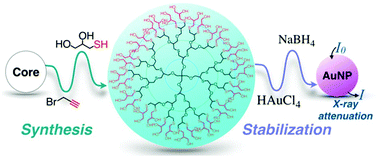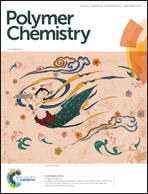An efficient approach to synthesize glycerol dendrimers via thiol–yne “click” chemistry and their application in stabilization of gold nanoparticles with X-ray attenuation properties†
Abstract
We report here a facile, robust and efficient synthetic approach to glycerol dendrimers in different generations with up to 256 terminal groups, by using a light-mediated thiol–yne “click” reaction and propargylation in an iterative fashion. Neither transition metal nor heating is required during the syntheses. The synthesized first (G1), second (G2) and third (G3) generation dendrimers are well soluble in water and are demonstrated to be nontoxic to HeLa cells. These dendrimers are good organic nanotemplates in the stabilization of gold nanoparticles (AuNPs) in aqueous solution, and a series of narrowly-dispersed AuNPs (d = 1.2–8 nm) were prepared. These AuNPs with good stability exhibit X-ray attenuation properties and thus could be potentially used as computed tomography (CT) contrast agents. In this study, the developed glycerol dendrimers with alkyne or hydroxyl termini would be a good platform for the construction of multifunctional theranostic nanoagents for targeted drug delivery and imaging of diseases.



 Please wait while we load your content...
Please wait while we load your content...